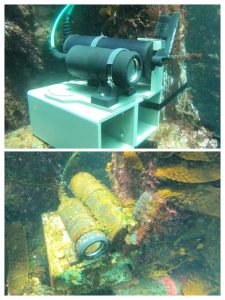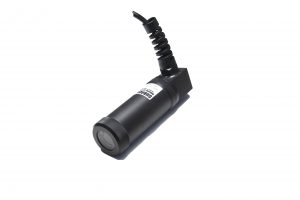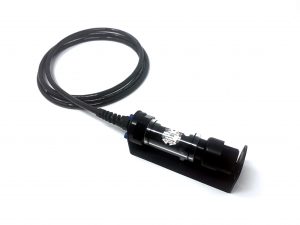Biofouling Prevention
SubAqua Engineers have been hard at work developing new products to meet the needs of our customers.
Cameras installed underwater for long periods of time face many challenges but one of the greatest is biofouling. Keeping the window clean and free of marine growth is a constant and often costly challenge. To this end, SAIS has developed two new products:

SubAqua Wiper & Camera assembly shown on the day it was installed and after being left unattended during the 3 months of highest annual marine growth in a shallow cove of Anacapa Island, California, USA.
The flat surface Wiper. This mechanical wiper is programmed to wipe a synthetic brush across the surface of a camera window or any flat surface needing protection. The wiper activates automatically on a regular basis to dislodge any debris and discourage bio-fouling from taking hold. The wiper is an IoT device with a settings menu accessible from a standard internet browser. Pre-programmable options include wipe interval and wipe sweep angle. A “wipe now” button allows the user to activate the wiper when needed. The wiper can be powered using PoE or 12V. For more information see http://www.saisweb.com/product/wiper-for-flat-surfaces/
UV Tube Light. Ultraviolet (UV) light is widely used for disinfection, sterilization, sanitizing and water purification. In the marine environment, UV light can be used effectively to prevent biofouling. SAIS’s UV Tube Light is a small light containing a powerful UV LED surrounded by a quartz tube that allows UV light to penetrate. The light is positioned in close proximity to the instrument, camera or other device to be protected. For more information see http://www.saisweb.com/product/uv-led-light/
Contact us at info@subaquaimaging.com for pricing, lead-time or more information.
Aquarium of the Pacific, Long Beach, CA, USA
 The Aquarium of the Pacific (https://www.aquariumofpacific.org/) has four SAIS cameras livestreaming through the Explore website (https://www.Explore.org). If you’re in the area, all the outdoor exhibits are open again!
The Aquarium of the Pacific (https://www.aquariumofpacific.org/) has four SAIS cameras livestreaming through the Explore website (https://www.Explore.org). If you’re in the area, all the outdoor exhibits are open again!
Sharks (SAIS IP HD CAM) – https://explore.org/livecams/sharks/shark-lagoon-cam
Blue Cavern (SAIS COMPACT CAM customized with an alternate module) – https://explore.org/livecams/aquarium-of-the-pacific/aquarium-pacific-live-cam-2
Jellyfish (SAIS IP HD CAM) – https://explore.org/livecams/aquarium-of-the-pacific/seajelly-cam
Coral (SAIS IP HD CAM) – https://explore.org/livecams/2 aquarium-of-the-pacific/pacific-aquarium-tropical-reef-habitat-cam
Coral (SAIS IP HD CAM) – https://explore.org/livecams/aquarium-of-the-pacific/pacific-aquarium-tropical-reef-camera
Choosing the Correct Cable for your Underwater Camera
There is currently no good solution for transmitting high quality video through the water, so even if your camera is battery powered – meaning that you don’t need to transmit power to it – you’re still going to need a cable to get live images back up to the surface.
The obvious – a cable used for an underwater camera must be watertight.
Cables for use underwater need to have some special features, most important of all though is to make sure that the inside stays dry. It is important to keep the copper conductors inside the cable dry so that there is no loss or interference in the signals and / or power being transmitted along them.
- The first special features used to achieve this is a robust jacket. Most cables for use above the water have a bundle of insulated conductors with a lightweight jacket around them. Underwater cables need to have a jacket that will not puncture easily and allow water to enter the cable bundle and compromise the conductors.
- The second feature used to keep your cable dry is to extrude the jacket tightly over the central core of the cable. SAIS has cable custom made by extruding a thick polyurethane jacket around the core.
- The third feature to keep underwater cable dry and also helps prevent damage to the equipment at either end of the cable is internal water-blocking. Water-blocked cables use a variety of methods to prevent water that has entered the inside the outer jacket from migrating along the length of the cable. In a typical application, one end of the cable will be submerged at some depth and so will be under more pressure than the other end of the cable at the surface. If the jacket is comprised and water enters, pressure will force it towards the lower pressure end of the cable at the surface, essentially turning the cable into a large siphon hose. Depending on how the topside of the jacket is terminated, this could result in water flowing out the top side of the cable onto essential equipment. The tightly extruded jacket around the cable is enough to limit this in many cases but water-blocking adds another barrier. The two main solutions used are water-blocking tape and water-blocking gel. The tape is wrapped around the inner core just below the jacket and absorbs any water that enters the jacket. The gel is injected inside the jacket filling the inner spaces.
Cross-talk and interference – preventing noise in your picture.
Many of our cameras are deployed around power sources, other underwater equipment and cables carrying signals to other equipment which can all be sources of electromagnetic interference. Oftentimes, these electromagnetic interference will show up in the video image as a lines, “marching ants” or “snow”. To prevent this, the core of the cable can be shielded by wrapping with a metal foil, metal weave or a single wire that wraps around it called a “drain” wire. More than one of these solutions is used in combination most of the time. The shielding can be grounded at one end of the cable – usually the topside – and thereby act like an antennae, capturing the electromagnetic radiation and diverting it the ground plane before it can interfere with the signal at the core of the cable.
Signal to noise ratio and impedance in broadcast and production cameras
High-definition 3G-SDI cameras used in the broadcast and production field use coax cable to transmit the video signal from the camera. The coax and all the cable terminations must be rated for 75 ohms of impedance and be large enough to carry the signal over the distance desired. The table below shows typical signal loss for several grades of coax cable. Once the signal loss is more than 20dB, the video becomes too poor to use.


Recent Comments